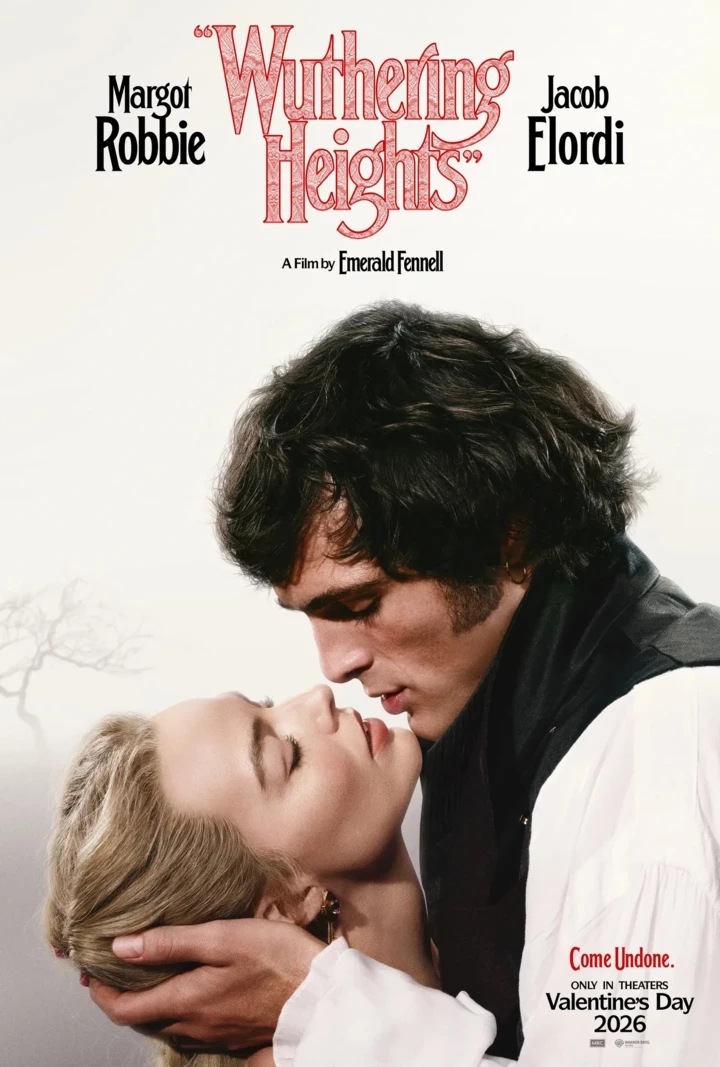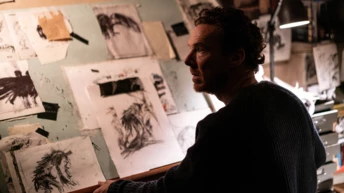
Save this storySave this storySave this storySave this story
The versatile, restless, maddeningly guileful artist Rashid Johnson—whose career-spanning survey exhibition, “A Poem for Deep Thinkers,” is now up at the Guggenheim, inhabiting almost the entire museum—is forty-seven. Normally, the age of the artist matters only as a kind of career timekeeping: it’s a quick, imprecise way to figure out whether you’re dealing with some upstart art star or an eminence taking one last valedictory turn, or a patient sufferer in that long purgatory of “mid-career.” But Johnson’s show, which unfolds chronologically, feels like one winding, thorny, searching, implicitly memoiristic half-century-long process of thought—a record of growing up.

A still from the video “Black and Blue,” 2021.Art work © Rashid Johnson / Courtesy the artist / Hauser & Wirth
No one aesthetic or approach to art-making can fully describe the ninety or so works that make up “A Poem for Deep Thinkers.” There are big, energizing houseplants hanging from the ceiling by barely visible strings. There are rugs on platforms and tables, making a soft surface for mysterious such experiments as shea butter carved and crumbled into pieces or, in one case, a dated video monitor showing Johnson practicing his own remixed version of yoga. There are satirical photographs and movingly earnest video. There are awkwardly hewn, possibly functional everyday items like fire pits and plant pots that Johnson calls “busts.” There are paintings—some on canvas and others on gleaming white tile.
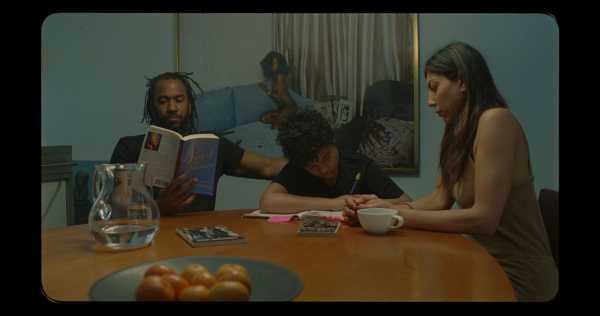
A still from “Black and Blue,” 2021.Art work © Rashid Johnson / Courtesy the artist / Hauser & Wirth
It’s an epic display of small ideas. But what gives the exhibition its coherence is Johnson’s consistent—if tonally varied—engagement with literature. “A Poem for Deep Thinkers” is named after a piece by the poet, playwright, and jazz critic Amiri Baraka, who is a kind of guiding spirit for the show. The prosy, preachy poem contains a miniature sermon on the role of the intellectual in society:
Such intellectuals as we is baby, we need to deal in the real
world, and be be in the real world. We need to use, to use, all
the all the skills all the spills and thrills that we conjure, that we
construct, that we lay down and put together, to create life as
beautiful as we thought it could be, as we dreamed it could be,
as we desired it to be. . . .
Johnson was born in 1977, into a middle-class milieu: his mother was a poet and a college professor, his father an artist and a Vietnam vet. If you put stock in the astrology of generational difference, you might notice an ambivalent strain of Gen X betweenness in his work. Blithe irony and startling sincerity are never far from each other in “A Poem for Deep Thinkers.” Perhaps this is a result of dual parentage. Johnson is steeped in the ethos and techniques of conceptual art (he likes slapstick humor and willfully crude craftsmanship); early in his career, he made objects whose effects lingered in the brain as opposed to the heart. But he also clearly knows, in a more harrowingly intimate way, the bloody, dusty, very non-conceptual history of the Black struggle in America. By the evidence of the show, Johnson’s art practice has been a protracted struggle with the “real world,” whose textures Baraka so ardently endorses.
Photography was a major focus of Johnson’s practice early on: he tended to use it to make pointed little historical jokes. Works such as his “Self-Portrait Laying on Jack Johnson’s Grave,” from 2006, and “Self-Portrait with My Hair Parted Like Frederick Douglass,” of three years prior, are witty, faux indifferent flirtations with a tradition whose moral gravitas fights back—perhaps too fiercely—against the art-historical games of, say, Duchamp, one of Johnson’s constant references.
Johnson is a good photographic subject: he’s got big soulful eyes and a graceful presence. He was a standout athlete as a kid; I’m sure one of his buddies has told him that he’s a dead ringer for the sphinxlike basketball star Kawhi Leonard, who—not unlike Johnson—always looks like he’s got a quiet joke that he doesn’t care to share. In these pictures, Johnson seems to be saying, “Yeah, I know all about it—the awful race riots that Jack Johnson’s boxing bouts sparked; Douglass’s escape from bondage and travel ever outward, hoisting the banner of human rights—but I can take the piss out of it, too.” Not so easy in practice. The pictures are funny, but they don’t carry any symbolic weight commensurate with that of their parodied subjects. You kind of laugh and walk by. It’s easy to tell that the younger Johnson—that interesting face—wanted something more.
Throughout the sixties and seventies, Baraka narrated a passage he made out of the world of white bohemia—the Beats and the New York School poets, and the whole world of slouchy sexiness that surrounded them—and into Black-militant consciousness. That journey is, in some ways, the founding myth of the Black Arts Movement, whose establishment was often credited to Baraka and his cohorts, such as the cultural critic Larry Neal. Johnson’s got an upward story to tell, too, but it’s different from and much gentler than Baraka’s. He came of age in Baraka’s wake: maybe the only way to deal with Black Arts’s loud, strident, sometimes imprecise declamations of racial pride was to bring them down to size by yukking it up.
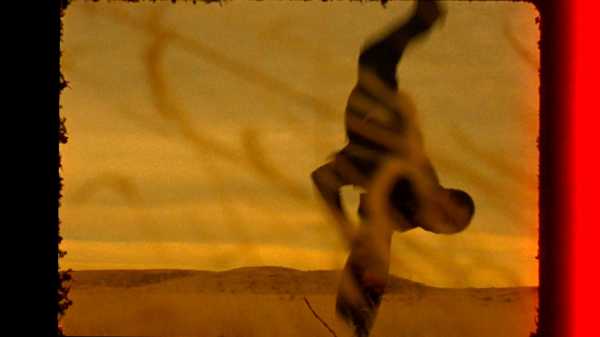
Stills from the video “Samuel in Space,” 2013.Art work © Rashid Johnson / Courtesy the artist / Hauser & Wirth
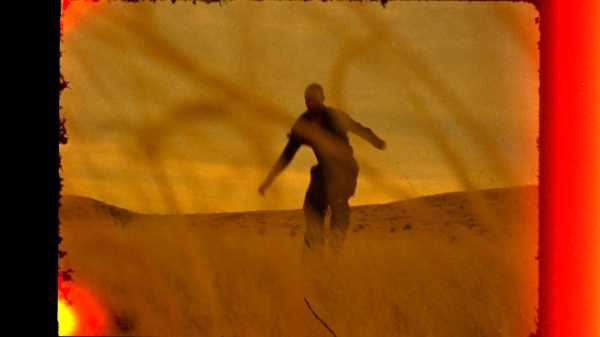

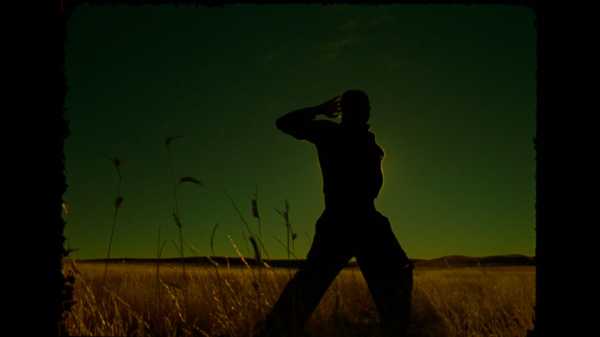
The story of “A Poem for Deep Thinkers” is of Johnson’s gradual flight from an underworld of concepts into the sunlit warmth of direct communication. Johnson’s not talking about getting radicalized, or even getting hip: he’s relaxing into a set-designed middle age, embracing its softening, and—true to his times—displaying a transformation that feels, in its deepest impulses, more therapeutic than political. Not far from the early photographs is a video work from 2004 which hints at heights to come: it’s a grainy, intentionally amateurish slice of life—Johnson’s in a small room, applying shea butter to his unclothed torso, and listening to the iconic Black interviewer Tavis Smiley’s talk show.
Johnson’s best work—it creeps up on you as you stroll up the Guggenheim’s ramp—feels like evidence of a life under way, a personality and an intellect unfolding in domestic privacy. One piece is so humble that you might miss it: a pile of books wrapped in tight layers of plastic, plopped atop a wooden pallet, quite low to the ground. It looks like a janitorial mistake until you look closer, and read the titles of the books. There’s “The End of Blackness,” by Debra J. Dickerson; “The Blacks,” by Jean Genet; and at least two collections—“Dutchman and the Slave” and “The Dead Lecturer”—by LeRoi Jones, who eventually gave himself the name Amiri Baraka. You could think of this unlovely mound as a Duchampian readymade: an emissary from the mundane world of living and moving, plucked out of its “real” context and presented as art. But it’s also a condensed encyclopedia of Johnson’s private and political concerns, a chronicle of highly literate, preciously won Black becoming.
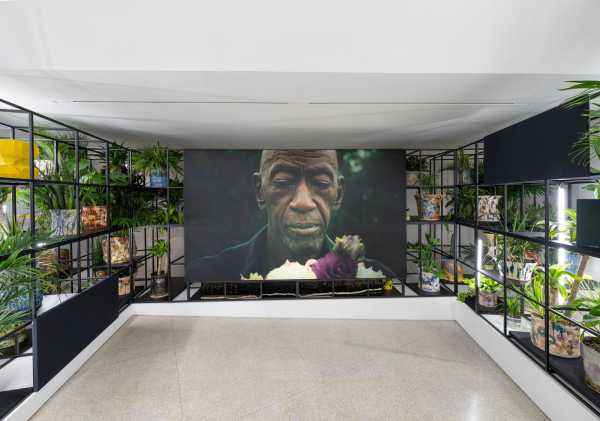
Installation view of “Sanguine,” 2024.Art work © Rashid Johnson / Courtesy Solomon R. Guggenheim Foundation; Photograph by David Heald
As the show ascends, it starts to seem like an especially charged display of home décor. Bookshelves predominate. Sometimes they’re affixed to larger consoles that look made to accommodate entire living-room units—there’s often a space on a broad shelf where a TV might plausibly go. The shelves hold books—often several copies of the same one in a neat stack—or record covers. It’s the stuff a certain kind of guy uses to put together an identity, a life. On one such contraption, “Death by Black Hole ‘The Crisis,’ ” there’s a high stack of Neil deGrasse Tyson’s essay collection “Death by Black Hole.” Perched atop so many Tysons are two worn copies of the book “Fatherhood,” by Bill Cosby. That collision of names—scientific popularizer and TV dad, pedagogue and performer, respected expert and lurid exile from respectable opinion—creates a mental aperture that can be filled only through questions about the work’s maker.
Johnson makes paintings and mosaics on square white tiles—often incorporating the material of one of Johnson’s favorite motifs, shea butter, the hearty soul food of moisturizing agents. One of these pieces is the monumental “Untitled Anxious Audience,” made in 2019. On a huge wall of tiles, many black faces are scrawled in a troubling grid. Their features are rudimentarily drawn, but clearly they’re under some kind of duress. The tiles call to mind the shower: What better place to be alone with your private angst?
At the top of the Guggenheim’s ramp, the upper level is dedicated to a sprawling installation of open cubic shelves that look like highly refined cubbyholes. In its hundreds of nooks, there are still more books and scores of plants—a literally living record of struggle and thought and pure-minded engagement. One arrangement of books within the piece—which is called “Sanguine”—caught my eye. Atop some volumes by the Chicago poet Gwendolyn Brooks, there’s a copy of an Alcoholics Anonymous manual. Have your art but also make a home, get weird, stay well: that’s a real life. ♦
Sourse: newyorker.com



